Master SFG Mark Reifkind insightfully warned, “Don’t live in your sports posture.” Which is where bodybuilding pull-ups and rows come in. As correctives.
I favor bilateral chest supported rows like Dan John’s “batwings” or Hammer machine rows. Why bilateral?—Because single-arm rows make it easy to get sneaky and avoid pinching the shoulder blades.
Single arm dumbbell rows can be an effective substitute to hollow position pull-ups as a general strength exercise for anyone or a “special strength I” exercise for wrestlers and MMA fighters. But we are in the corrective territory now, and if you are trying to open up, a single-arm row is not the right tool for the job. So bilateral it is.
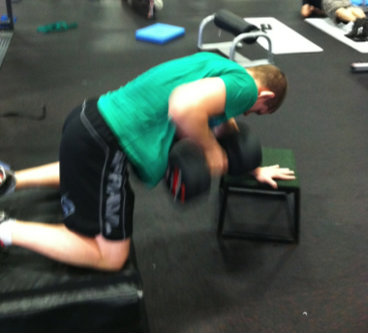
The Problem With Bent-Over Barbell Rows
I like chest supported rows because they spare the lower back and the glutes. Bent-over barbell rows trash the erectors through a long static contraction. Your lower back can take only so much work; would you not rather give it its allowance in more productive ways like deadlifts or kettlebell swings and snatches? We want a strong back, not a tired one.
Of course, there are plenty of examples of elite powerlifters doing heavy bent-over barbell rows: Dr. Mauro DiPasquale for his bench press, Brad Gillingham for his deadlifts, and so on. But these are special exercises selected by world class athletes totally in tune with their bodies—not general ones, to be used by all athletes or even all powerlifters. Many powerlifting stars do just fine without rows, thank you very much.
The Dead Row
There is one bent-over barbell row variation that spares the lower back, while offering additional benefits: the “dead” row. (Note: don’t try it if you have long legs and a short torso.) Olympic weightlifting coach Glenn Pendlay explains the drill:
“…the best way to do them is to start with the bar on the floor every single rep. Your middle back will have slight bend to it. You pull the bar off the floor quickly with the arms, and by a powerful arch of your middle back. You finish by touching the bar to your upper stomach or middle stomach. At no time is there any movement of the hips or knees, no hip extension at all. All that bends is the middle back and the shoulders and elbows.
This is hard to do and you have to have good muscular control to do it, or you’ll end up straightening up at the hips along with the arching of the back. But if you can master doing them this way you will get a big back…
The bar returns to the floor after each rep. The bent row is actually best done as an explosive movement and the bar is moved fast.”
The Tug of War Row
The tug of war row by Russian strongman Valentin Dikul is another good choice of a row. It does fatigue the lower back and glutes, but not as much as the bent-over row.
Attach a V-handle to a low cable stack. Back off far enough from the stack to run the cable at an approximately 45-degree angle. Sit back and dip your knees slightly, as if you are playing tug of war, and row.
This cable row variation is a lot safer on your lower back because it does not encourage flexion and it teaches a useful athletic skill that martial artists call “rooting.”
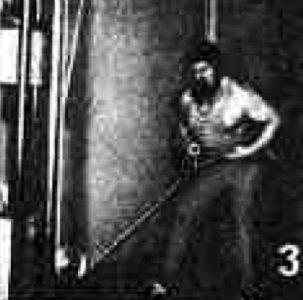
Suspension Trainer Bodyweight Rows
Suspension trainer bodyweight rows are okay when one is weak and almost upright. When your body is parallel to the deck and you are cranking out reps, your cheeks have to stay clenched for the duration. Wearing out the glutes on a corrective just does not seem right. Save them for heavy deads, crisp swings, and upper body general strength exercises like bench presses and handstand push-ups.
Other Options
There are also row-free solutions to countering the hollow position: various barbell pulls from Olympic weightlifting, double kettlebell high pulls, double kettlebell snatches, bent presses, etc.
Until then, go get strong.
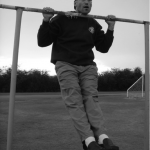
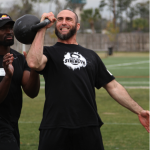
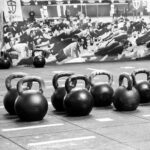
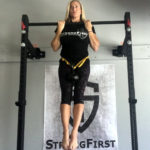

Hello Pavel,
I have a question about the relation between pull-ups and rows and their emphasis on lats and middle Trapezius. In your “Best Upper Body Pull” article, you give the example of a high level acrobat having huge lats but no rhomboids. From that I understand pull-up doesn’t really train upper back muscles. Is there a technique to help upper back muscles involve more in the pull-up process? I realized that if I hang onto bar with shoulder width arms, I can use my upper-back muscles better at the top. It is way harder to do so with more than shoulder width hang. I think retracted scapulae is advised for this reason in “bodybuilding pull-up”. You instead talk about sunk-in chest and flared scapulae, what do you mean by that?
Besides that I have another question regarding rows. In your previous books and videos, you suggest to engage lats and upper back muscles to keep shoulders in their sockets. This is especially true when doing push-ups and bench press to engage chest muscles and protect shoulders. Would you suggest same thing for rows too? I can’t imagine rowing with elevated shoulders.
Thank you,
Is 54321 3times/week enough for pendlay rows? It’s the only back exercise I do right now.The others are C&P, squat and bench. Emphasis to get stronger on all exercises.
Hey Pavel,
I have a question for you. In your series about the best lifts, the KB clean appears in Hip hinge, KB military press in Press and now your mentioning KB snatch and high pulls in corrective back exercise. Every time they don’t appear as the best lift because they require higher volume or shoulder stability or ….
Wouldn’t it be just better to work on a good KB clean and press (push press maybe), add in some squats and pull-ups and be done with it?
Hollow position + correctives. A new, succinct Pavelism.
I like rows from a lunge with the opposite arm braced on the forward knee. Have you tried that?
Steven, I have the same opinion of all unilateral rows—may be useful for general strength; not so good for the retractors.
What do you think of Front Lever rows?
Aragus, an advanced special strength exercise for gymnastics.
Chief, how does the back angle affect on rows? I’ve sometimes done “dead barbell rows” out of low boxes as I don’t feel pendlay rows from the floor feel very safe. The height is couple inches below knee cap. This puts my back around 35-45 angle from ground.
Teemu, it defintely does and your solution is a good one, given that you, Finns, are built to deadlift!
pavel i am a big fan of yours since 2001 2 question what happen in dragon door why u left and i have books and dvds that u have made i love it but i am still not that strong . tight my body help to me to get stronger i try and try tight all my body parts at same time w power exaltation, how can i apply it in combat ? thank u
Noe, I answered you in the blog about different kettlebell sizes.
thanks pavel, i have been suffereing from what i think is a tightening of my hip flexors from the bent over rows i do with my c&p ladders from rite of passgae. this has been making swings and snatches very difficult some days.
would i be better switching exercises or moving the rows to my variation days as i have felt that the tightness in my lower back has been effecting form lately.
by the way your ladder program in enter the kettle bell is awesome and i have been getting great results. respect to you and your work.
gianni
gianni, if there is a real need for row in your program, then they do belong on variety days.
Fatman, you are right.
I’m still a big fan of the Shoulder dislocate with a bungee cord ala Super Joints. Its done wonders for my posture.
Ian, the dislocate is a fine exercise indeed.
Mark, GREAT article, lots of food for thought, my man!
Thanks, Zach!
Pavel, I’m training at home lately without any weights, mostly trying to do one-arm push-ups. Do I need correctives? Is the chest expander any good?
Aris, that is a question for your doctor, strength coach, or corrective specialist.
The chest expander is a powerful tool for developing an upper back that’s strong from all angles, but almost no one uses it. No other device allows you to use very high resistance to train your upper back with virtually zero stress on your lower back.
Good upper back exercises include the front chest pull (essentially a scapular retraction with resistance), the overhead downward pull (works the lats without fatiguing the arms), straight-arm one-arm pulldown (also lats) and the “shoulder shimmy” (a scapular shrug with cables held behind the neck and the arms fully extended throughout).
You can also work the shoulders and arms very effectively with a chest expander. But for upper back development nothing beats cables IMO.
Thank you both. I use a 45 degree arm angle, something between front and downward pull ,feel that’s the angle I’m strongest in. It’s just that sometimes my neck tightens up, probably due to shrugging..I think it really teaches you how to tense your upper back..